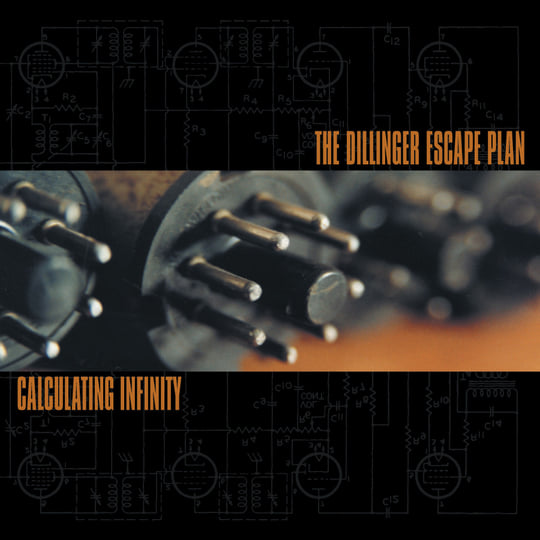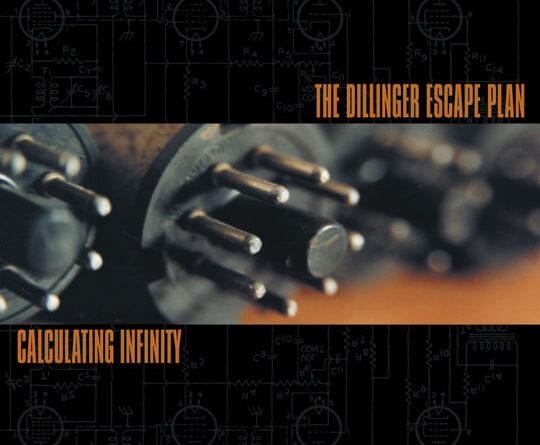HEAVY MUSIC HISTORY: Calculating Infinity – The Dillinger Escape Plan
Few albums have ever scarred the face of extreme music more indelibly than Calculating Infinity by THE DILLINGER ESCAPE PLAN. Mathcore, noisecore, chaotic hardcore – whatever you want to call it all that stuff had developed into something quite special over the course of the 90s, starting essentially with the criminally underrated RORSCHACH right at the dawn of the decade, and then being twisted into all sorts of fascinating shapes by the likes of DEADGUY, BOTCH, CONVERGE and COALESCE over the years that followed. By 1999 there really wasn’t much of a rulebook left to rip up, but DILLINGER were about to throw whatever remained of it out the window anyway. And then set it on fire. And piss on it.
Formed initially as more of a political hardcore outfit known as ARCANE in 1996, THE DILLINGER ESCAPE PLAN had set about making a name for themselves from the moment they changed it. Even then their shows were the stuff of violent legend, the earliest of which saw them opening for such esteemed metalcore luminaries as OVERCAST and EARTH CRISIS. In the summer of 1998 they embarked on their first proper North American tour with JESUIT and the aforementioned BOTCH, their then-unreleased sophomore EP Under The Running Board having earned the approval not only of the former’s Nate Newton to land them the gig, but also of the heavyweight Relapse Records who released it in the October of that year.
Angular, dissonant, and wildly unpredictable, Under The Running Board was in many ways the perfect amuse-bouche for the main course to follow, though even the relatively short time between records would see some changes to the cooks in the kitchen. Guitarist John Fulton departed soon after the EP’s release, replaced in turn by JESUIT’s Brian Benoit, while bassist Adam Doll was tragically paralysed from the chest down in a car accident shortly before recording for Calculating Infinity began.
Eager not to lose momentum, the band entered producer Steve Evetts’ studio in March 1999, with bandleader Ben Weinman performing most of the guitars and bass while Benoit focused on getting up to scratch for their live shows. To be fair, Weinman was and always would be the band’s mastermind anyway, their material at this point defined most of all by the push and pull between the guitarist’s insistence on aggression and intensity, and drummer Chris Pennie’s increasing pursuit of technical complexity.
“I think the relationship with Chris and I, creatively and everything, was a huge part of creating an original sound,” reflected Weinman in a 2021 interview with Machine Music. “For me, it was about being punk and energetic and bringing to people what seemed to be the feeling and experience that people were getting from the original hardcore bands like BAD BRAINS and BLACK FLAG. And I knew that in order to do that we had to create music that was pushing things way farther than those bands did in order to give people the same feeling that people got when they first saw those bands for the first time. So while Chris was sitting in the basement and going through charts, I just wanted everything to be faster and louder or more aggressive and more violent.”
This is the knife-edge that Calculating Infinity walks from the moment opener Sugar Coated Sour fires off its first volley of frantic guitar tapping and stuttering snare hits, as bewilderingly technical as it is physical and kinetic. To reach for one of the only comparisons that doesn’t feel completely one-sided, where a band like MESHUGGAH use similar dexterity to create something machine-like and imposing, DILLINGER do it in a way that only ever feels intensely human, the sense that it could all come flying off the rails at any moment only serving to heighten the sheer giddy thrill of it all. Vocalist Dimitri Minakakis grounds the record in a primal fury too, his blunt force delivery as central to the uniquely violent character of this album as his successor’s versatility was to the expansionism of those that followed.
Not that Calculating Infinity is lacking a breadth and diversity of its own, of course. When it’s not straight up trying to peel your skin off with molten mathcore it’s burrowing deep beneath it with meandering jazz runs or menacing ambient interludes or maddening washes of noise – all meticulously woven into the album’s mesmeric tapestry. “Every note had a purpose,” elaborated Weinman in the aforementioned Machine Music interview. “It was organized chaos. To a lot of people it just sounded like noise, but every single note, every single hit was intentional. There was nothing left to chance.”
Arriving the same year as some truly gargantuan commercial behemoths from the likes of SLIPKNOT, LIMP BIZKIT and fucking KID ROCK, Calculating Infinity wasn’t exactly the dominant flavour of its day, but the band still made damn sure it didn’t go unnoticed. They toured relentlessly upon its release, playing legendary metalcore festivals like Hellfest and Furnace Fest and even a few dates on the Vans Warped Tour that no doubt saw them terrify a bunch of kids who’d paid to see GREEN DAY and NOFX in the process.
But for every person that left confused, plenty others left converted, the album’s classic status growing from ‘cult’ to ‘undeniable’ as it went on to rack up over 100,000 sales by 2013. The band’s ambition would only grow with every record that followed, each a worthy contender for their very best, but Calculating Infinity will always be the one that made them. Narrow down the entire genre of mathcore to just one essential document and this is it: an album that has spawned an ocean of imitators but few genuine rivals in the 25 years it has walked this earth. Oh, and that 43% Burnt’s a banger isn’t it?

Calculating Infinity was originally released on September 28th, 1999 via Relapse Records.
Like THE DILLINGER ESCAPE PLAN on Facebook.

